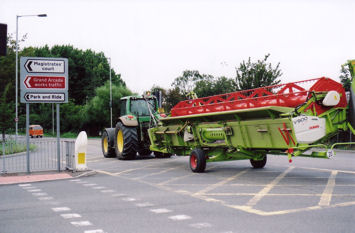This is the second of three pages about the agricultural revolution and the enclosure of Trumpington. See also the introductory page and the background to farms and farming .

The agricultural “revolution” included:
• technological changes (such as the introduction of the seed drill, new crop rotations, better use of fertilisers and improved livestock breeding)
• the replacement of labour with machinery
• the enclosure of open fields
• and the redistribution of previously unused land
The changes started in the mid 17th century and became established as standard practice in the 19th century. The impact is demonstrated by the doubling of agricultural output in the 18th century as compared with the 16th and 17th centuries. There was also a significant increase in labour productivity, to a much higher level than on the continent.
The enclosure movement included converting common land into private property, consolidating separate areas into larger units. It is estimated that 50% of land had already been enclosed by 1600 and the process continued through the 17th century, with 70% enclosed by 1700. It accelerated in the 1760s, when Parliament accepted privately-promoted Inclosure Acts, with a further 20% being enclosed by 1815.
The process was regional, with some parts of the country barely affected, East Anglia later than some other areas. When it was implemented, it was an important catalyst for change: it had a great effect on the landscape and society, with field boundaries, hedges and fences being established, new farms constructed away from the village, tracks and paths diverted or lost, crop rotation and husbandry practices changing and people losing historic entitlements such as rights of pasture and collecting firewood and berries and also losing a communal way of working.
John Clare wrote of his despair at the enclosure of Helpston , 1809:
Helpston:
Hail, humble Helpstone! where thy valleys spread,
And thy mean village lifts its lowly head;
Unknown to grandeur, and unknown to fame;
May:
And where enclosure has its birth
It spreads a mildew oer her mirth
The herd no longer one by one
Goes plodding on her morning way
In contrast, Thomas Gainsborough exemplified the role of the advanced land owner when he placed Mr & Mrs Andrews in their fertile Suffolk estate (1748-49) (painting on display at the National Gallery). This shows the newly-married couple posing under an oak tree, with the sheaves and stubble of a partly-harvested cornfield to the right and sheep in an enclosure in the middle distance. Mr Andrews indicates satisfaction with his well-kept and prosperous estate, demonstrating his control and ownership, untroubled by the presence of the workers who created his wealth. The sheep in an enclosed area show that he had a progressive concern with selective breeding programmes. With Gainsborough’s own prosperous background, the artist readily identified with the upper-class clients and was in sympathy with the local countryside. He created an image of a rolling naturalistic landscape with changing weather, using rich warm colours to evoke an English idyll.
Major landowners had a large part to play in the adoption of new agricultural practices by leading by example, but it is now thought that the importance of this has been overemphasised, to the detriment of the role of lesser landowners, estate stewards and tenant farmers, who also had a pioneering role. However, there was a rise in the number of large estates in the 18th century, with a concentration of power over the introduction of new rotations and improved husbandry. Land also remained a good investment, as a result of which landowners could put resources into improving their estates and developing their art and antiquity collections. The rights of landowners over mineral resources such as coprolites also led to further wealth.
Sources
Beckett, John V. (1990). The Agricultural Revolution . Oxford: Blackwell. ISBN 0-631-16287- 9.
Evans, Eric J. (2001). The Forging of the Modern State: Early Industrial Britain, 1783-1870 . Harlow: Pearson Education. ISBN 0-582-47267-9.
Continue with the enclosure of Trumpington.